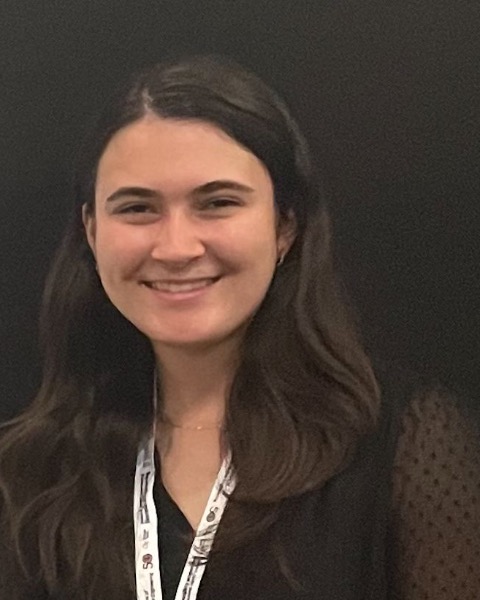Drug Delivery
(I-335) Chemical Activation of Piezo1 to Enhance TRAIL-induced Apoptosis in Glioblastoma Cells

Samantha Knoblauch, current undergrad
Undergraduate Researcher
Vanderbilt University
Nashville, Tennessee, United States- JD
Jenna Dombroski
Graduate Student
Vanderbilt University, United States 
Shanay H. Desai (he/him/his)
Undergraduate Researcher
Vanderbilt University
Nashville, Tennessee, United States
Nicole S. Sarna (she/her/hers)
PhD Student
Vanderbilt University
Nashville, Tennessee, United States- JH
Jacob Hope
Graduate Student
Vanderbilt University, United States 
Michael R. King (he/him/his)
J. Lawrence Wilson Professor and Department Chair of Biomedical Engineering
Vanderbilt University, United States
Presenting Author(s)
Co-Author(s)
Primary Investigator(s)
Materials and Methods:: GBM cells were treated with DMSO (10μM), Yoda1 (10μM), DMSO + TRAIL (25 ng/mL), Yoda1 + TRAIL, and TMZ (50μM or 200μM), in which DMSO served as a vehicle control for all experiments. An Annexin-V and Propidium Iodide (AV-PI) flow cytometry assay was used to measure cell viability 24 h (U87) or 4 h (LN18) after treatment. For this, cells were stained with 3% AV and 5% PI. A JC-1 flow cytometry assay was used to quantify mitochondrial depolarization of U87 and LN18 cells, using a JC-1 antibody at 40μM. A calcium flux assay was also performed via flow cytometry using 1μM Fluo-4 and 2μM Fura Red fluorescent dyes to quantify the calcium influx into GBM cells upon treatment. Cells were treated with 1μM, 5μM, and 10μM of DMSO and Yoda1. FlowJo software was used for gating and analysis. Additionally, U87 and LN18 cells were seeded onto glass coverslips and fixed after 48 h, followed by staining for Piezo1, DAPI, and actin. Images were acquired at 20x using a Zeiss LSM 710 Confocal, and analysis was performed using FIJI.
Results, Conclusions, and Discussions::
Results and Discussion: Yoda1 + TRAIL treatments significantly decreased cell viability compared to controls in both cell lines (Fig. 1A-C). This was further supported by a significant increase in mitochondrial depolarization for the Yoda1 + TRAIL treatment compared to control conditions (Fig. 1D-E). Overall, the LN18 cells were more sensitive to this treatment than the U87 cells, although the treatment duration was shorter. This combination therapy was more effective at inducing apoptosis in LN18 cells compared TMZ treatments (Fig. 1A-E). LN18 cells also showed a significant increase in calcium influx for the Yoda1 treatment at each concentration measured (Fig. 1D). There was no significant difference in calcium influx in U87 cells for these same Yoda1 concentrations (data not shown), suggesting saturation of Piezo1 channels in this cell line. This finding was also reflected in Figure 1G, which showed that LN18 cells express significantly more Piezo1 than U87 cells.
Conclusions: Yoda1 + TRAIL treatments increase apoptosis relative to controls in both GBM cell lines and are more effective at inducing apoptosis in LN18 cells compared to TMZ, the current standard of care. The increased Piezo1 expression in LN18 cells correlates with increased sensitivity to the Yoda1 + TRAIL treatment compared to U87 cells. These results are supported by an increased mitochondrial depolarization upon Yoda1 + TRAIL treatment and suggest that the intrinsic TRAIL apoptotic pathway is executed, although other downstream pathways may also be activated. This study demonstrates that mechanotransduction enhances the therapeutic effects of TRAIL, and introduces this combination therapy as an alternative, transcription-independent GBM treatment. This therapy may be useful for treating TMZ-resistant tumors or could be used in combination with TMZ to target two different apoptotic pathways in GBM cells, which may improve patient outcomes.
Acknowledgements (Optional): :
This work was supported by NIH Grant R01 CA203991.
References (Optional): :
[1] LE Schnöller, Radiat Oncol, 2022, 17, 79; [2] FA Lincoln, Cell Death Dis, 2018, 9, 1-14; [3] JM Hope, Cell Death Dis, 2019, 10, 1-15; [4] SV Knoblauch ACS Omega, 2023, In Press.
